Talk about a contrast in styles.
Spain’s victory over Germany provided one of the most entertaining matches of the tournament. It was an exciting blend of attacking and defensive tactics leading to the thrilling overtime victory. The Marc Cucurella handball controversy simply added to the intrigue.
France’s shootout victory over Portugal, well, they won with stifling tactics. The “just win” mentality produced a boorish 0-0 outcome after 120 minutes, but it led to Didier Deschamps’ side’s shootout triumph.
The pre-tournament favourites have three goals and five matches. Despite the embarrassment of riches, two of the three goals were contributed to by the opponent and the third came from a Kylian Mbappé penalty kick. France has made it clear they’re not here to entertain; they’re here to win.
This tactical analysis will preview the semi-final matchup by examining some of the attacking focal points and defensive trends of the two teams. However, no analysis that includes this French side is complete without an investigation of their pragmatism and the impact their tactics have on the match.
This is a Spanish side that has found a nice blend of attacking and defending, but will it be enough to produce a goal against this talented, ultra-conservative French side?
Let’s dig into the matchup in this preview analysis.
The importance of wing play
Looking at the two teams, wing play will be central to each team’s success, but for very different reasons.
For the Spanish, this is where their dynamic playmakers reside. Nico Williams, our breakout star for the Spanish side, has had a brilliant tournament. He has offered a threat running at the opponent’s 1v1 in the wings, offering runs behind the back line and cutting inside to create for himself and his teammates.
Then there’s the young Barcelona star, Lamine Yamal. The 16-year-old hasn’t had quite the tournament that Williams has had, but he’s offered a steady presence on the right. Between his 1v1 ability and the quality of the services he’s putting into the box, the teenage sensation has managed to pick up a couple of assists. Like Williams, he has shown he’s capable of progressing the ball on his own in the wing, as well as cutting to the inside. He’ll miss his right-sided partner, Real Madrid‘s Dani Carvajal, who misses the game while serving a red card suspension, but Spain will continue to support him with Jesús Navas likely to earn the start.
Looking at each team’s ball progression map, the trend to find the wide players in high positions is evident. Comparing the two maps, Spain’s approach certainly has more variety, with a greater emphasis on the half spaces and finding the high central target more frequently.
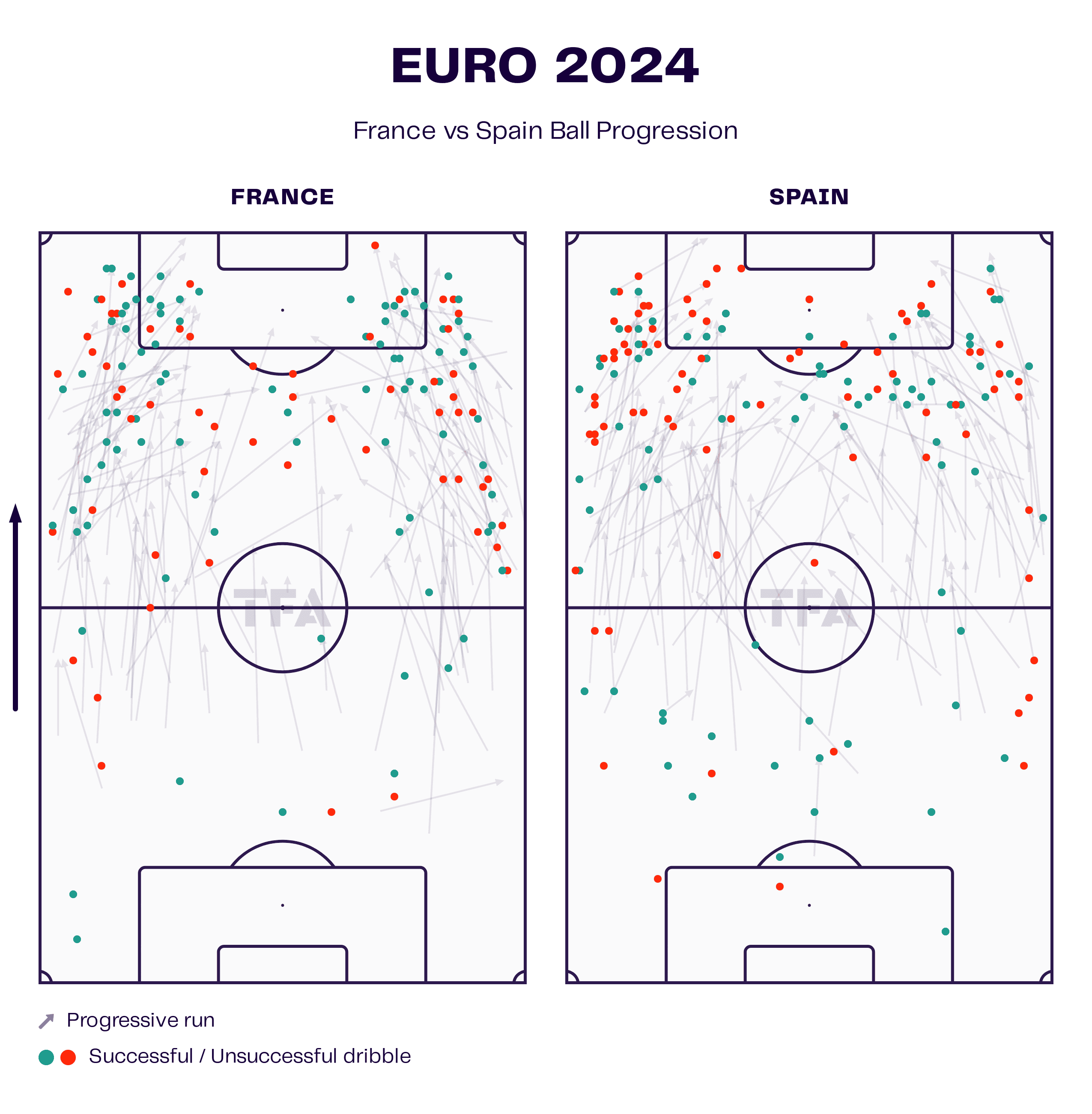
Here, we see the difference in approach. For France, there’s a greater emphasis on finding the wide players, typically the two outside backs, as they move into the final third. We’ll touch on this momentarily, but even France’s ball progression signals their defensive intent and hints at their issues in possession.
Let’s finish the analysis of Spain’s wide play first. For the Spanish side, there’s an emphasis on isolating their young wingers. Carvajal’s lung-busting runs at the right-hand side have offered 2v1s and 2v2s to the Barcelona youngster pretty consistently, but the objective for Spain is to put Williams and Lamine Yamal in a position where they can use their 1v1 ability to move into the box and offer a high-quality service.
Spain has had tremendous success generating goals from wing play. With the exception of an Álvaro Morata goal, Spain has used the wings to create their opportunities on goal. Take this Dani Olmo goal against Germany as an example. Lamine Yamal has the ball on the right and occupies two German defenders. One is there in a first-defender role, but a second is required to provide cover. The teenager lowers the tempo of the attack just enough, allowing Morata to make a far post run to stretch the back line. Olmo then bursts into the space created by the #9 before applying the finish to the far post.
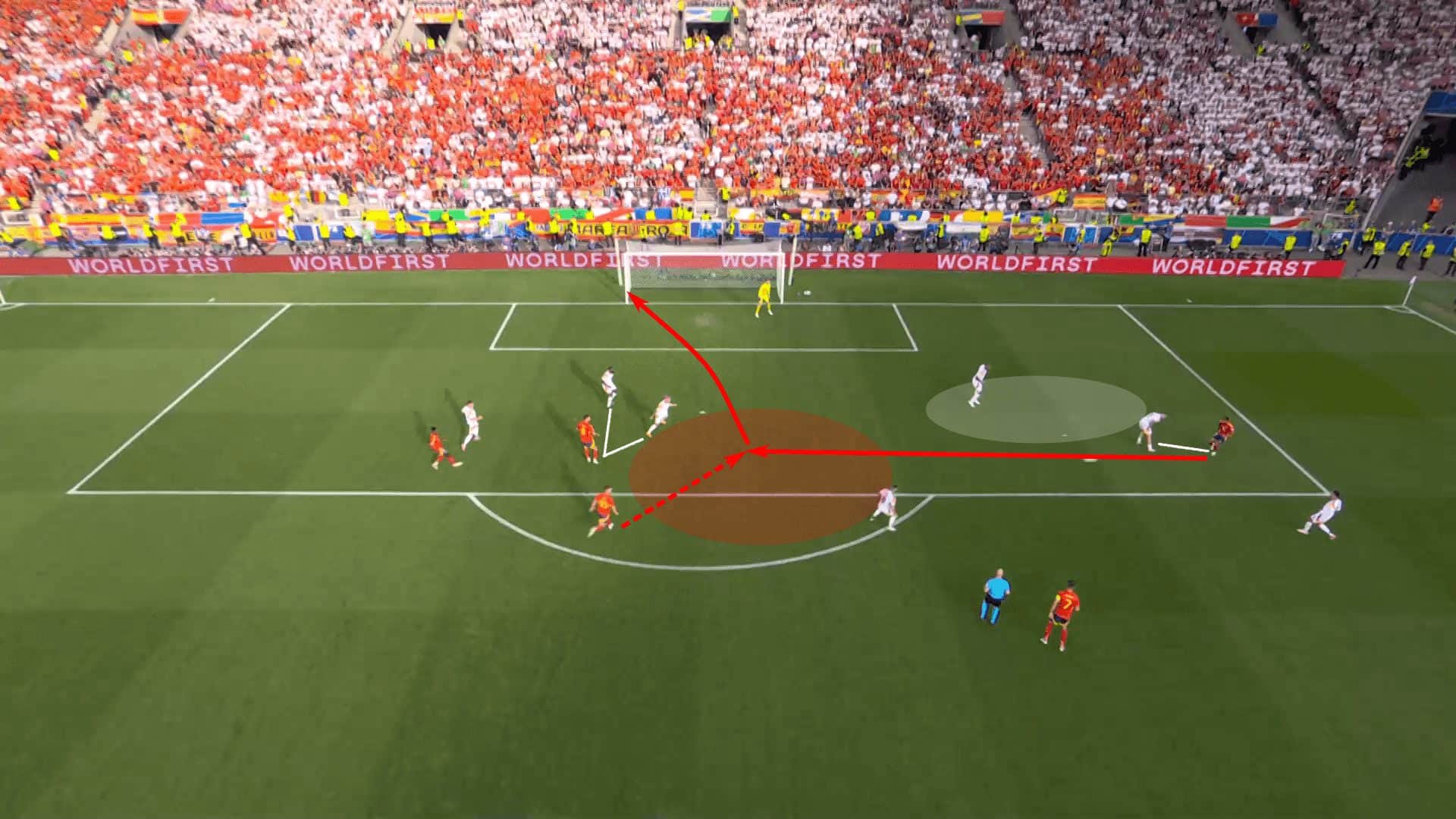
When Spain is in possession in the middle third, the wide players will offer a blend of high and wide positions and inverted starting points in the half-spaces. Williams, in particular, has been a menace with the dynamic role he has played, and his right-sided partner has done the same, as seen in the image below. In this case, rather than taking the ball out wide, which he initially shows, he makes a nice cut to the inside before unleashing a tame shot from approximately 30 m.
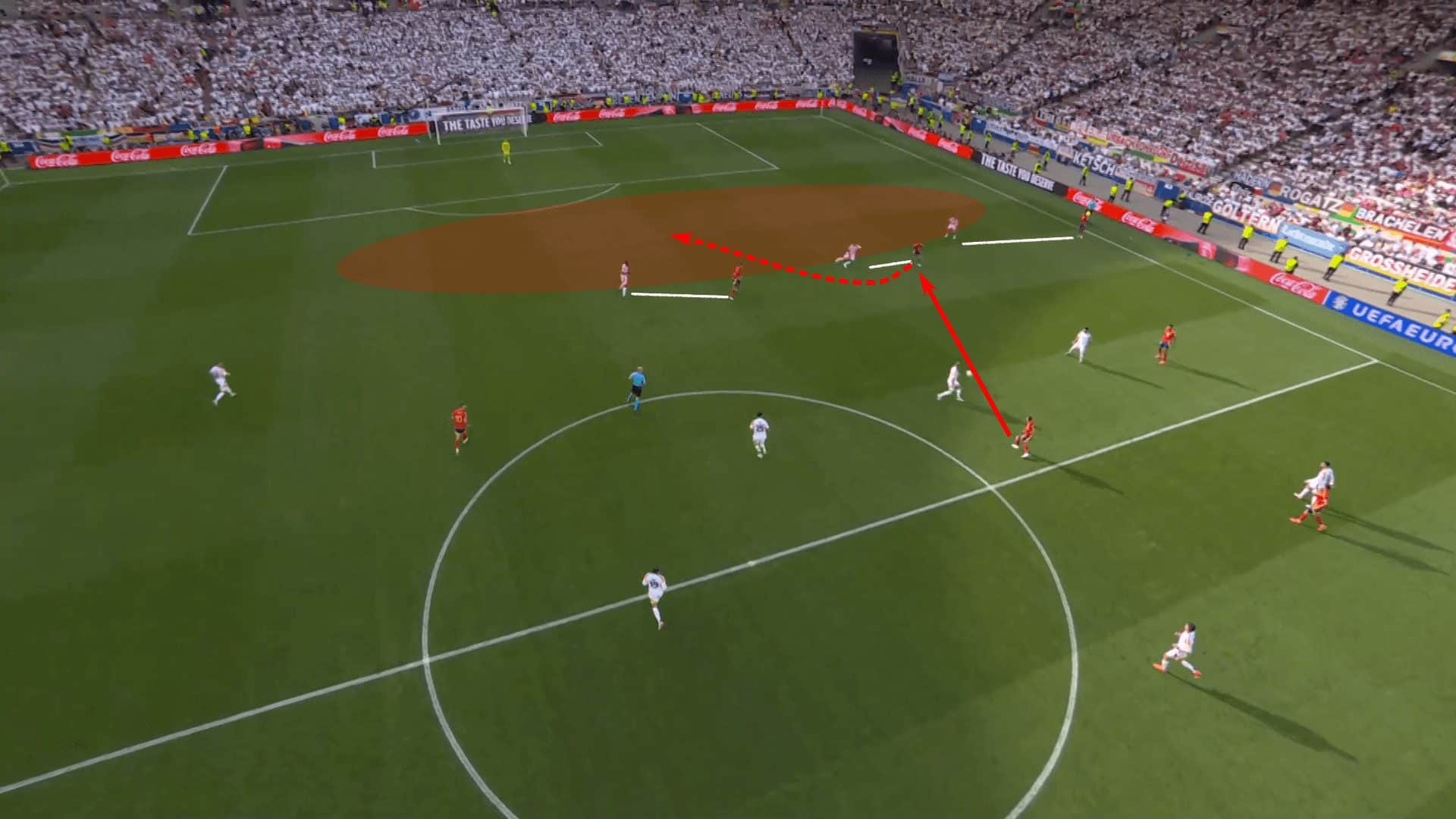
Despite the decision with the shot selection, it’s the work he does before the shot that showcases the threat posed by Spain’s wide players. Whether receiving in the wings or cutting to the inside, they’re a constant threat to beat their mark and create chaos.
That’s in contrast to this French side. They’ve used some mixture of a 2-3-5 or 3-2-5 in possession, with Theo Hernández and Jules Koundé offering width. Their starting points have pushed Mbappé more centrally and allowed France to use Antoine Griezmann as a de facto right-forward with license to roam.
The goal here isn’t necessarily to create through the wings. Rather, it’s the consequence of attacking with defending in mind. You could say defending is not only the top priority for the French side but arguably the only priority. If their individual quality produces a goal on top of that they’ll take it, but they’re equally comfortable playing out the match with a 0-0 scoreline. Their approach epitomizes a “don’t lose” mentality.
When France is in possession, there’s a greater emphasis on creating through the left side. They’ll use Mbappé and Hernández to try and break down the opponent, then play into Griezmann and whoever else joins him up top.

To counter that left-sided creation, Portugal routinely moved three or four players to the left side to limit Mbappé’s impact and force hopeful deliveries from Hernández. This is all while accounting for the limited runners France pushed into the box. With the Portuguese side fully prepared to deal with services, France’s success was extremely limited.
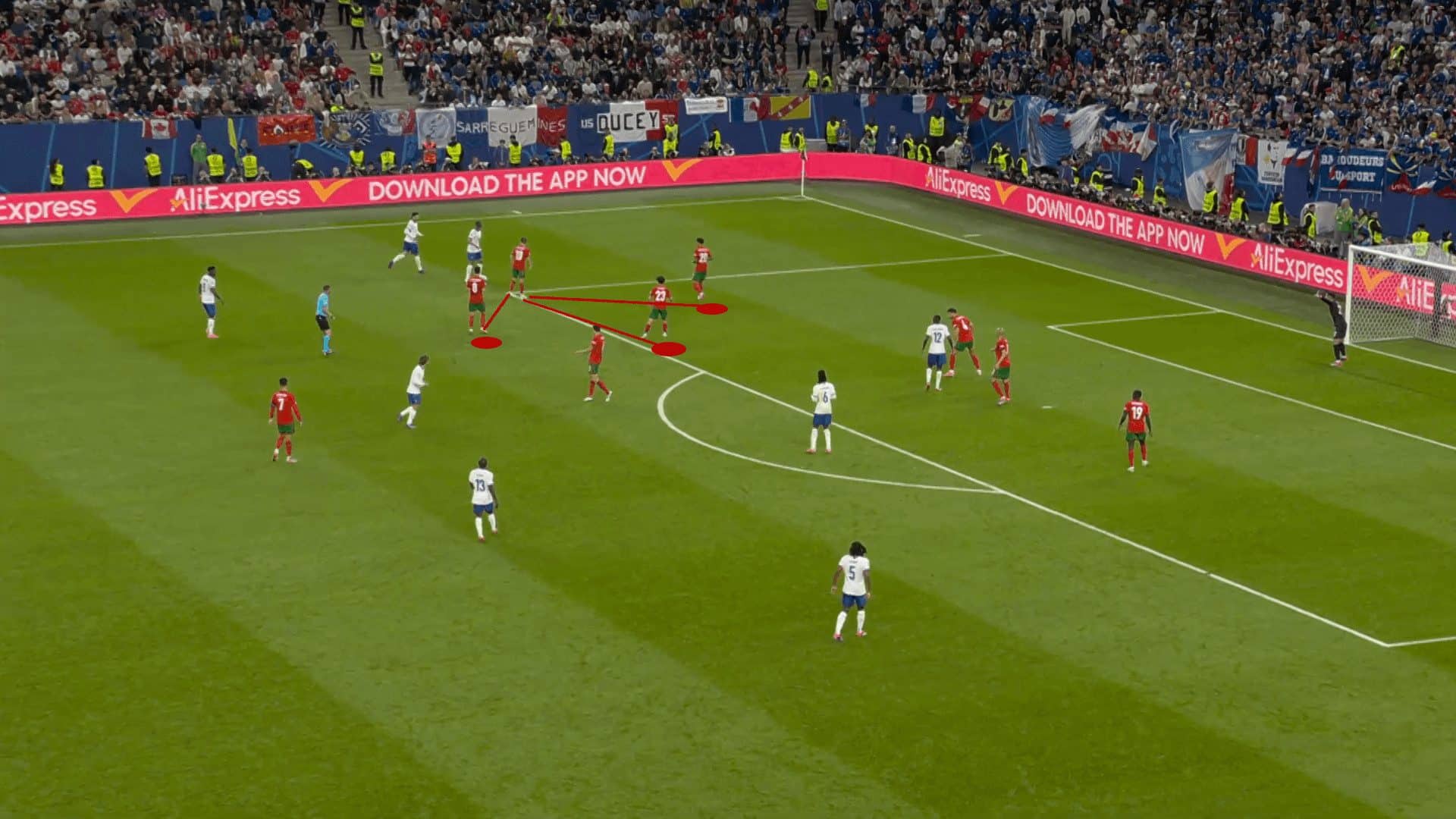
By playing in the wings, France reduces the playing area. This means that when the ball is lost, they’re well-positioned to counterpress. In essence, France’s rest defence is designed to optimize their efficiency in recovering their defensive shape and prevent the opponent from quickly picking out forward passes. That slight delay gives them valuable seconds needed to move from attacking to defending shapes.
Where France has looked most dangerous is when Ousmane Dembélé has played on the right. While the PSG player’s final product hasn’t quite been there, he has been dangerous on the dribble and created for teammates.
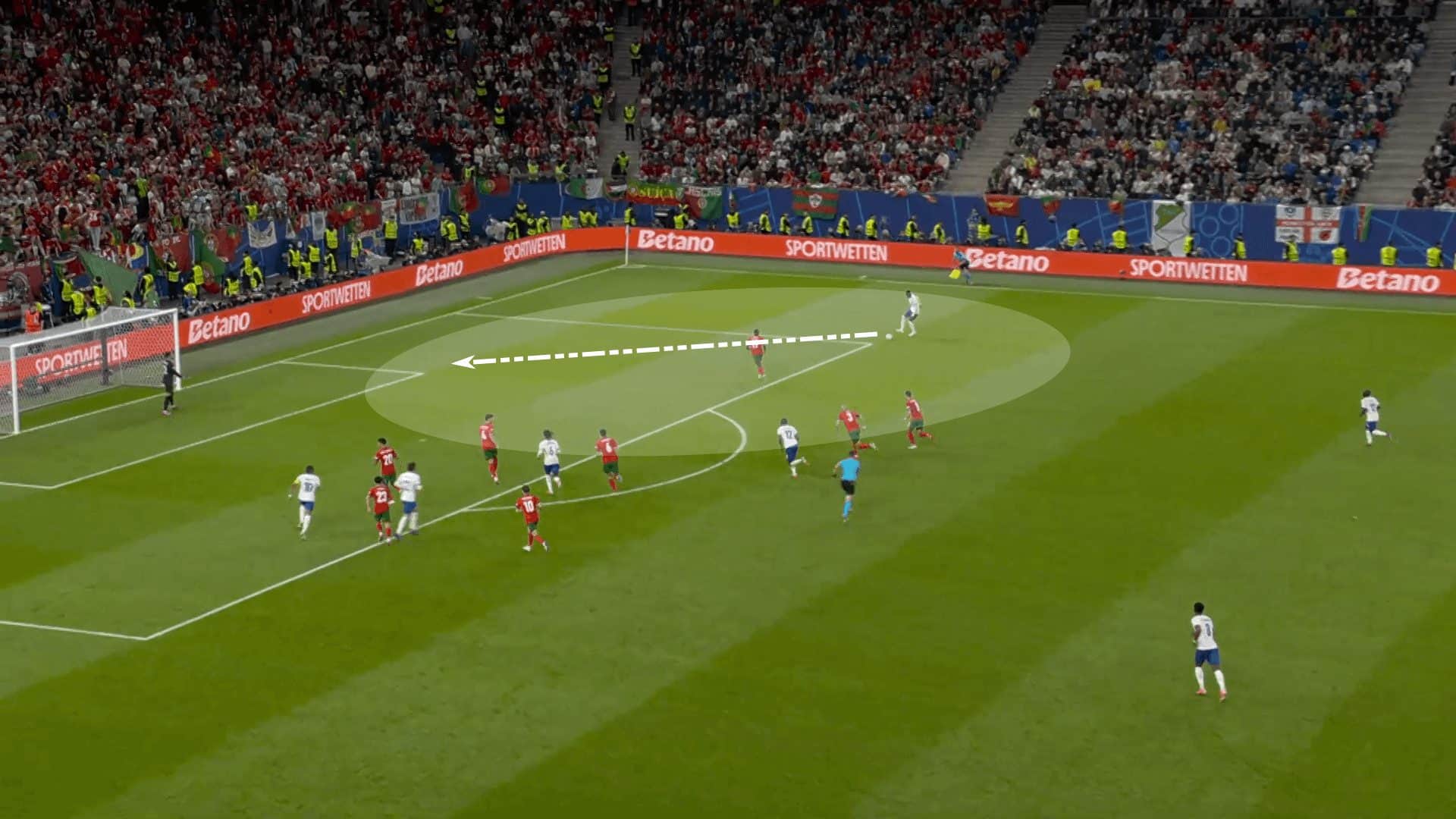
The images above and below are connected. Portugal had so much respect for Dembélé’s dribbling prowess that Pepe slid over in coverage and created a gap at the corner of the six-yard box for Eduardo Camavinga, who received and pulled his shot just wide of the post.
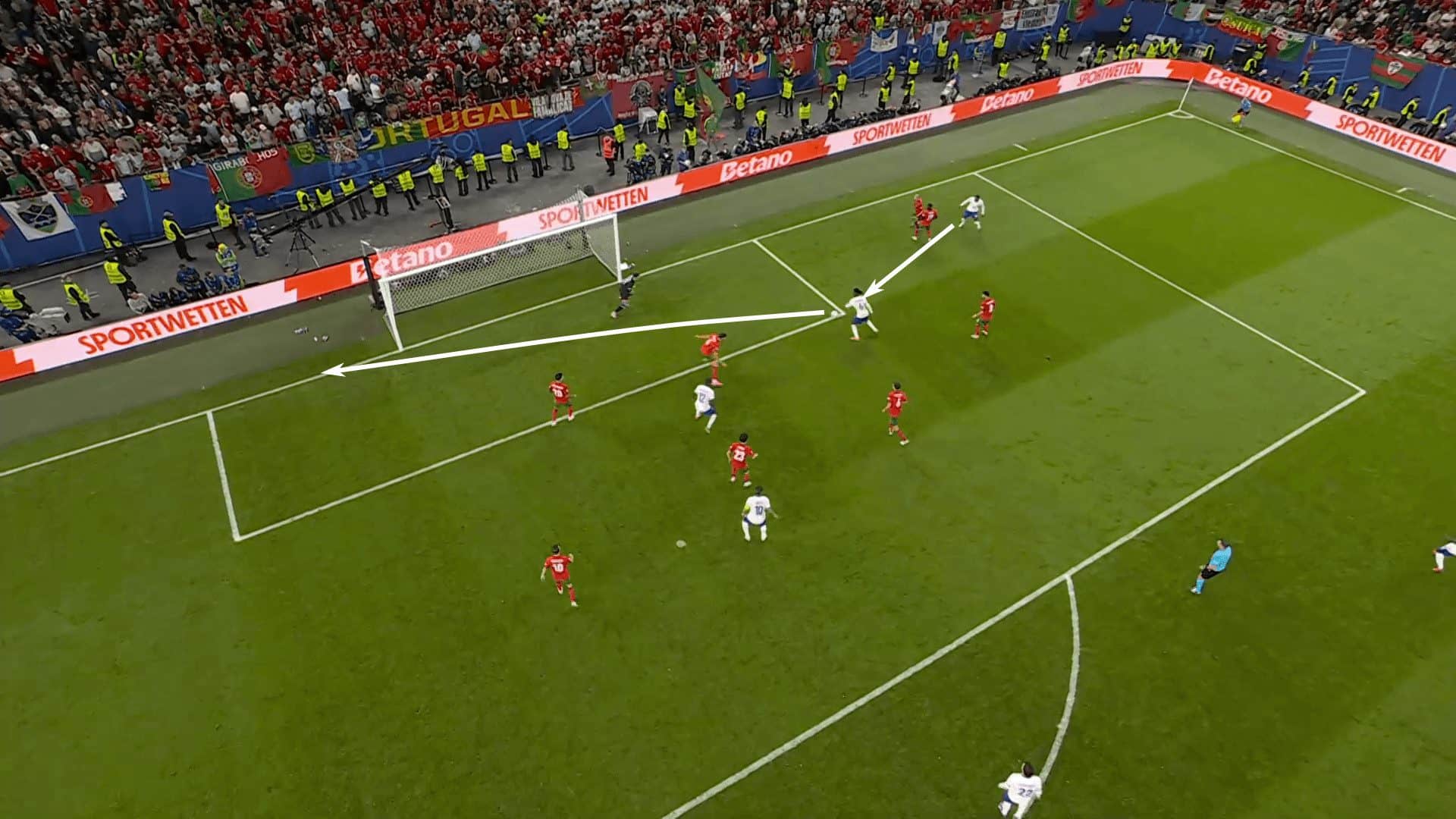
It’s the dynamism offered by the wingers that has Spain among the top scorers in the tournament, while the lack of it, combined with some poor finishing, has kept the French players off the score sheet, minus that penalty kick conversion by Mbappé. Wing play will be crucial for both teams, but certainly for different reasons.
Contrasts in defending tactics
Spain’s intention to impose the terms of the match through their fantastic high press were on display against Germany. If there was a team in this tournament capable of beating the Spanish press, Germany is one of two or three names that would come to mind.
The first example comes from a goal kick, giving us a sense of how the Spanish will approach their defensive tactics from a dead-ball situation. Against Germany, the Spanish had a clear intention to take away the centre of the pitch, funnelling the Germans into the wings and then ramping up pressure on the outside backs. We’re going to see here how they used two high players to nullify the two centrebacks and goalkeeper while having Williams start further toward the interior. Once Manuel Neuer played his pass wide to his Bayern Munich teammate, Joshua Kimmich, the Athletic Club star had his trigger. As Williams moves to apply pressure, the Spanish team’s narrow defensive shape simply slides to the ball-near side of the pitch and intensifies pressure near the ball.
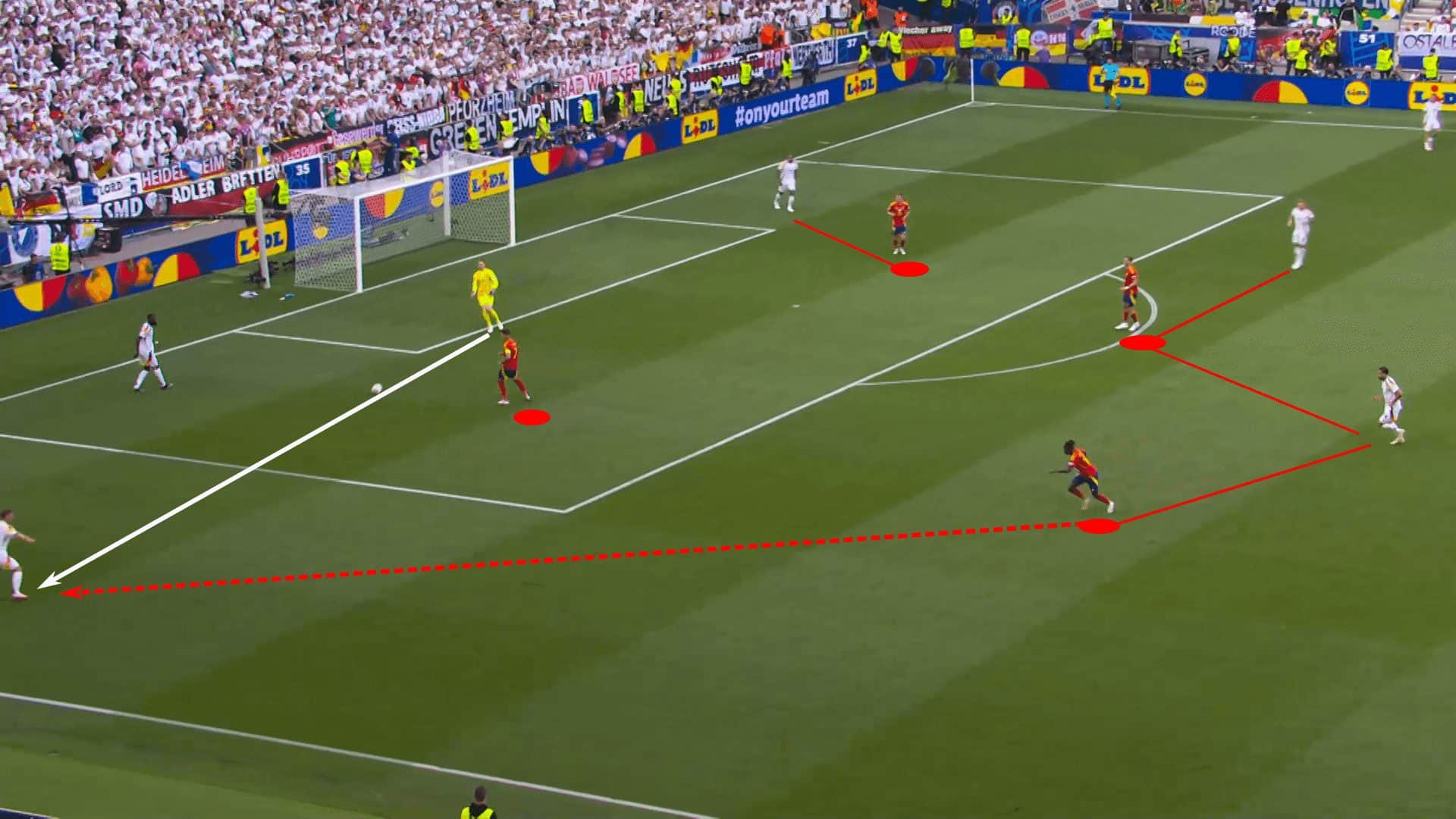
In open play, there’s a concerted effort to force the deepest players to take charge of the build-out while also pushing them to deeper and wider parts of the field, using their positioning and pressure applied on the ball to limit the options available to the first attacker.
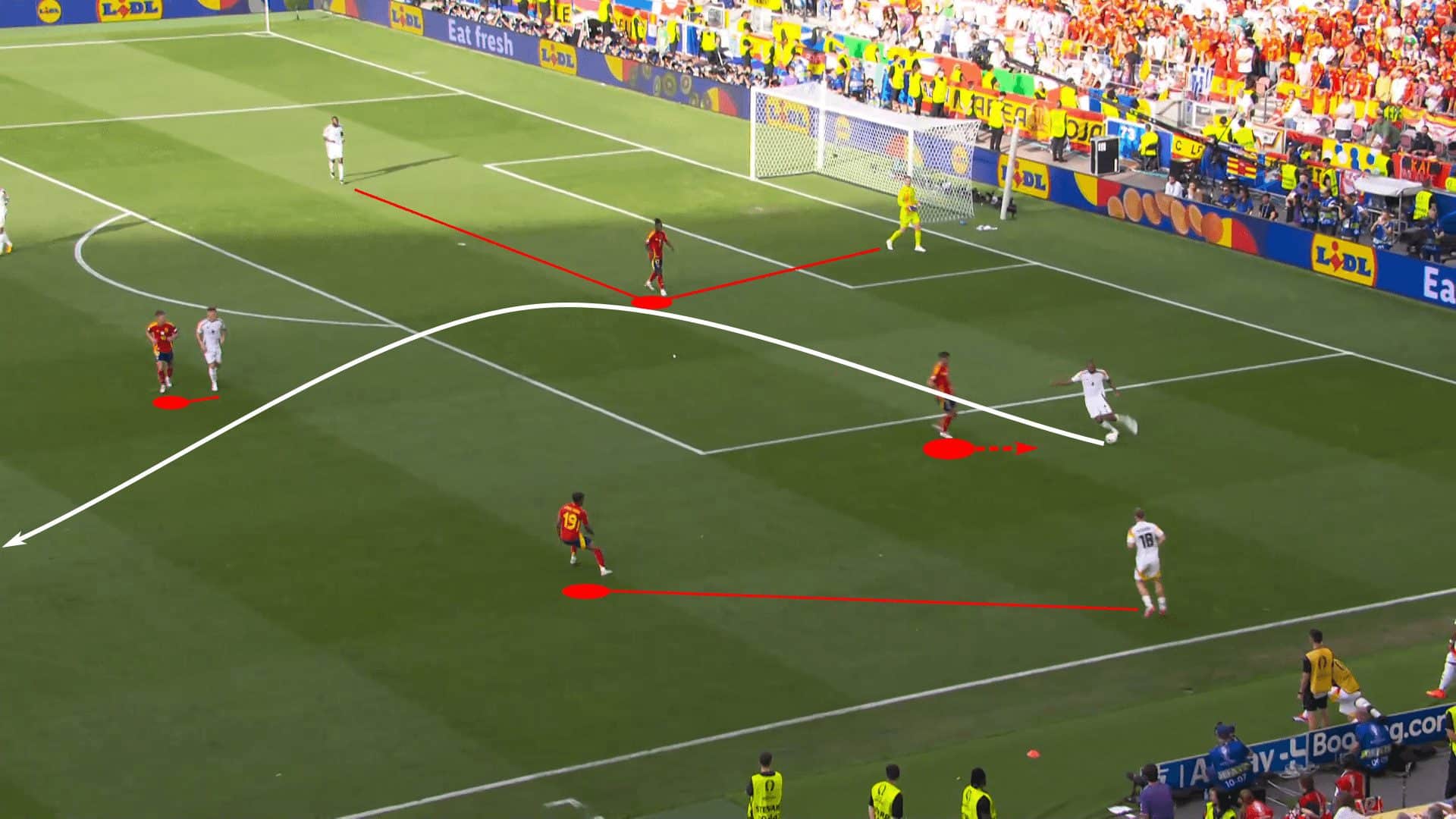
In the image above, Spain’s pressure forces a long pass, which, looking at the image below, plays right into Spain’s hands. The ball goes right into an area of the pitch dominated by Spanish numbers, and the intense pressure on the ball forces an errant pass.
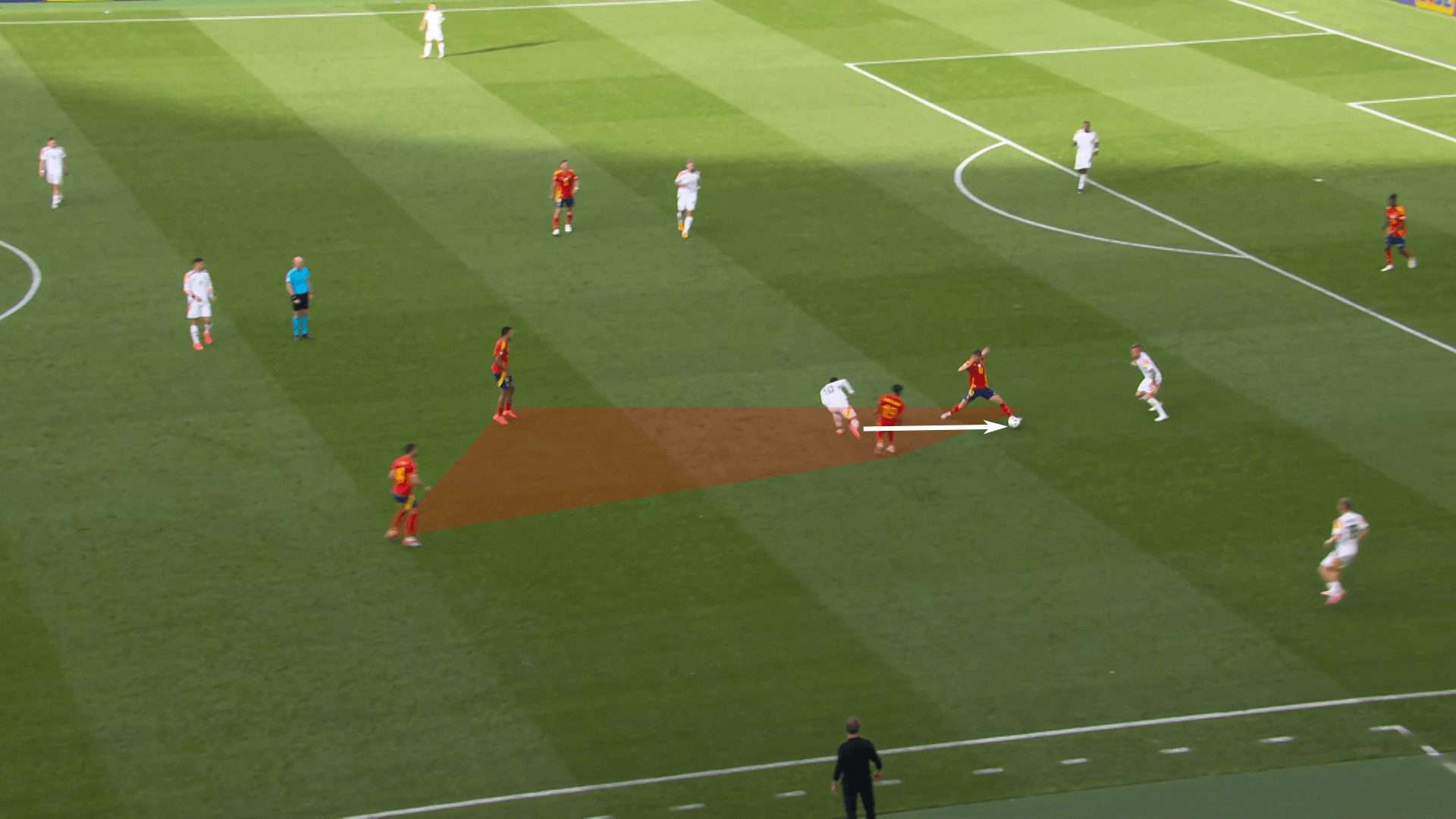
If the Spanish high press is broken, look for them to simply drop numbers behind the ball. This is where they’re a little more vulnerable. They’ll still allow passes into the wings, which isn’t necessarily a threat but may play into the way they want France to play. The greater vulnerability is that they will push two central midfielders higher into the press, leaving Rodri to defend space between the lines. If France can keep him central in support of the centre-backs, they’ll find open pockets in the half-spaces.
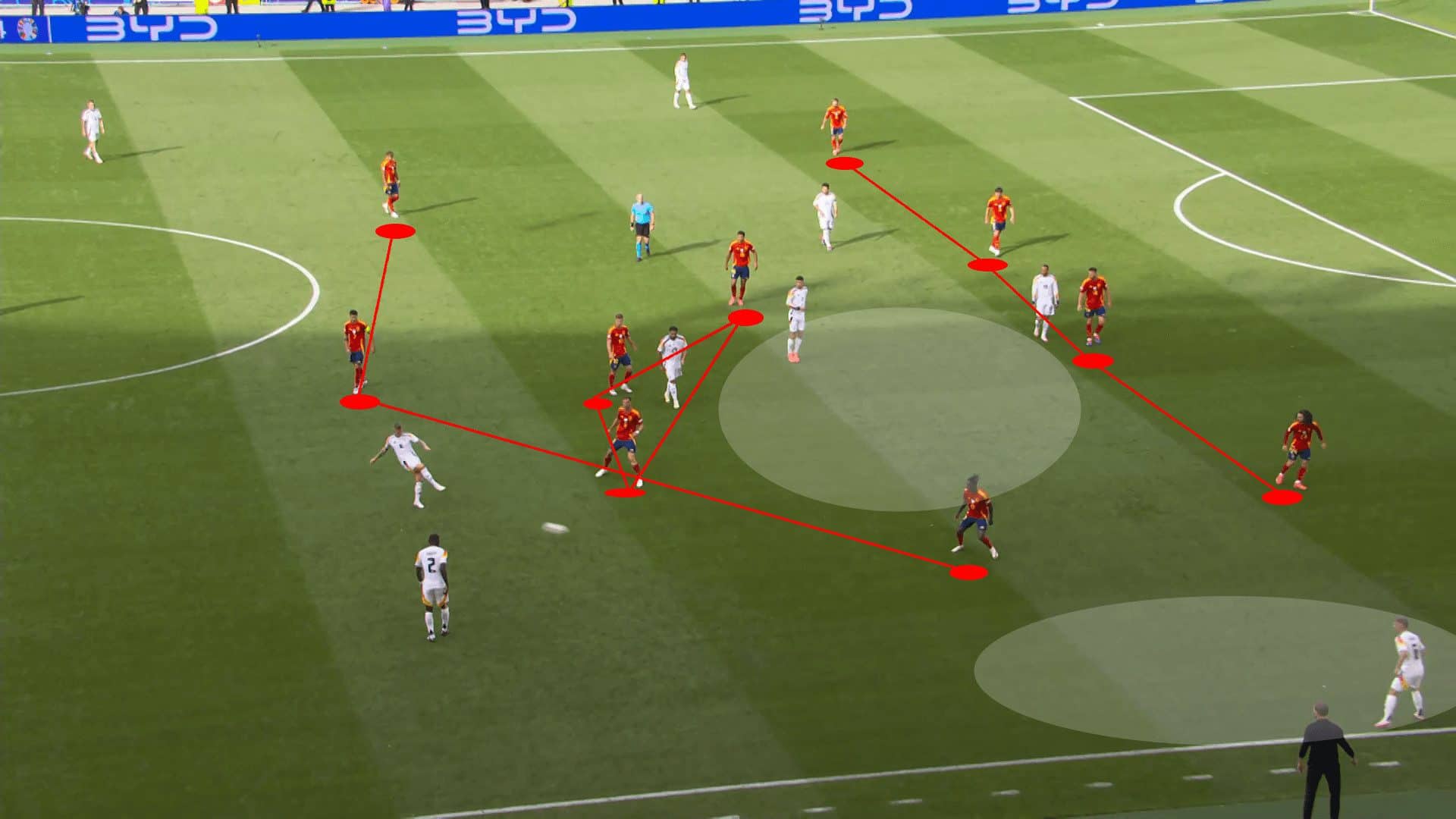
For France, look for a very similar approach to their match against the Portuguese. If there’s an opportunity to apply high pressure while limiting options at the back, they will, but that’s not the priority. The objective is keeping numbers behind the ball and clogging the centre of the pitch.
Against Portugal, Griezmann often shadowed the Portuguese #6, João Palhinha, and France used the forward and midfield lines to congest the centre of the pitch. They gave the Portuguese the wings, which the Iberian side gladly took, given that that’s where their most dynamic players were.
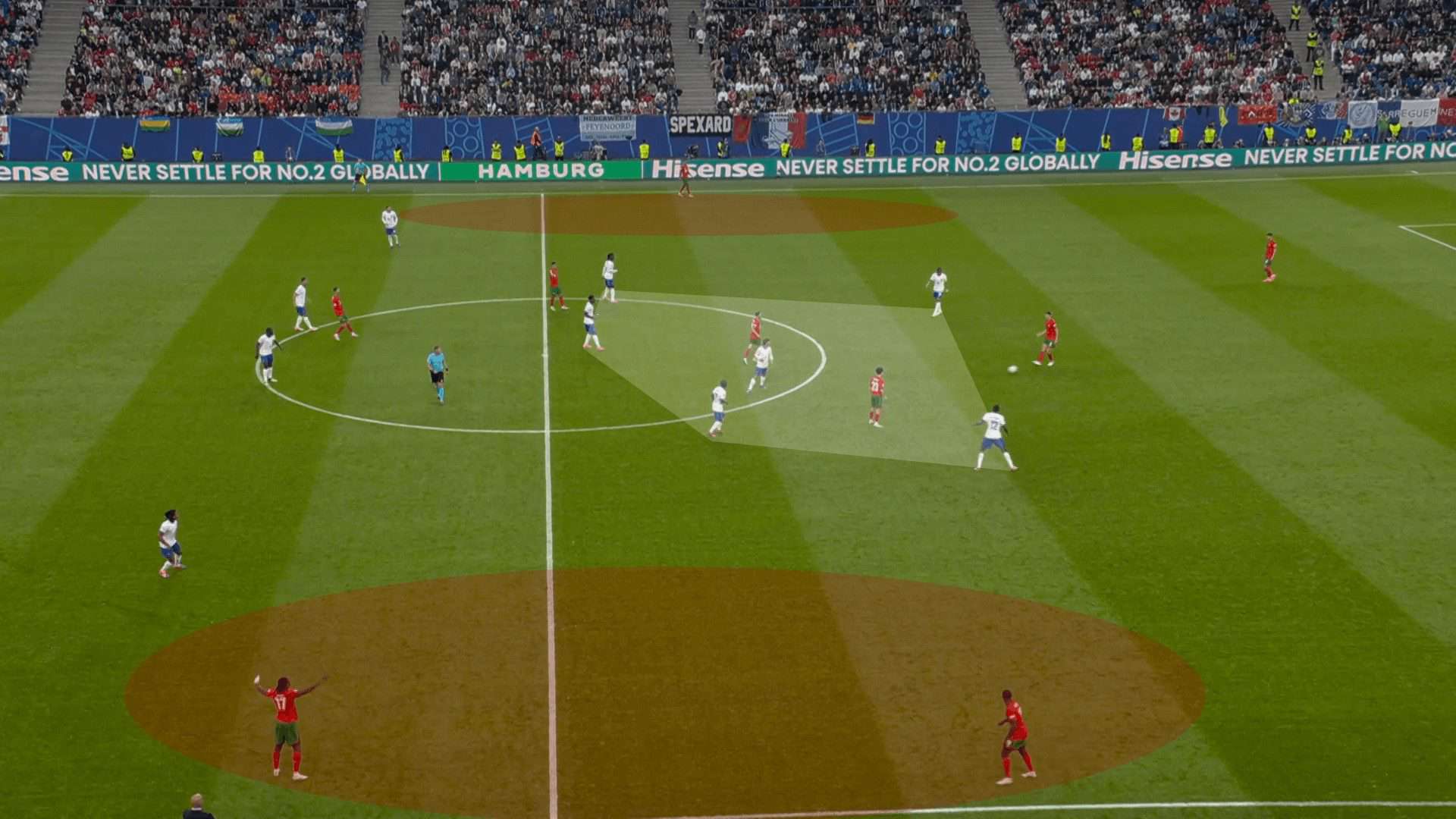
Look for something similar from France and this match. That comes with the pros and the cons. The pro is that it limits the opposition’s midfield. The con is that it gives top talent in the wings the freedom to engage in 1v1s and 2v1s. In this instance below, a clever backheel from Rafael Leão played PSG’s Nuno Mendes behind the French press.
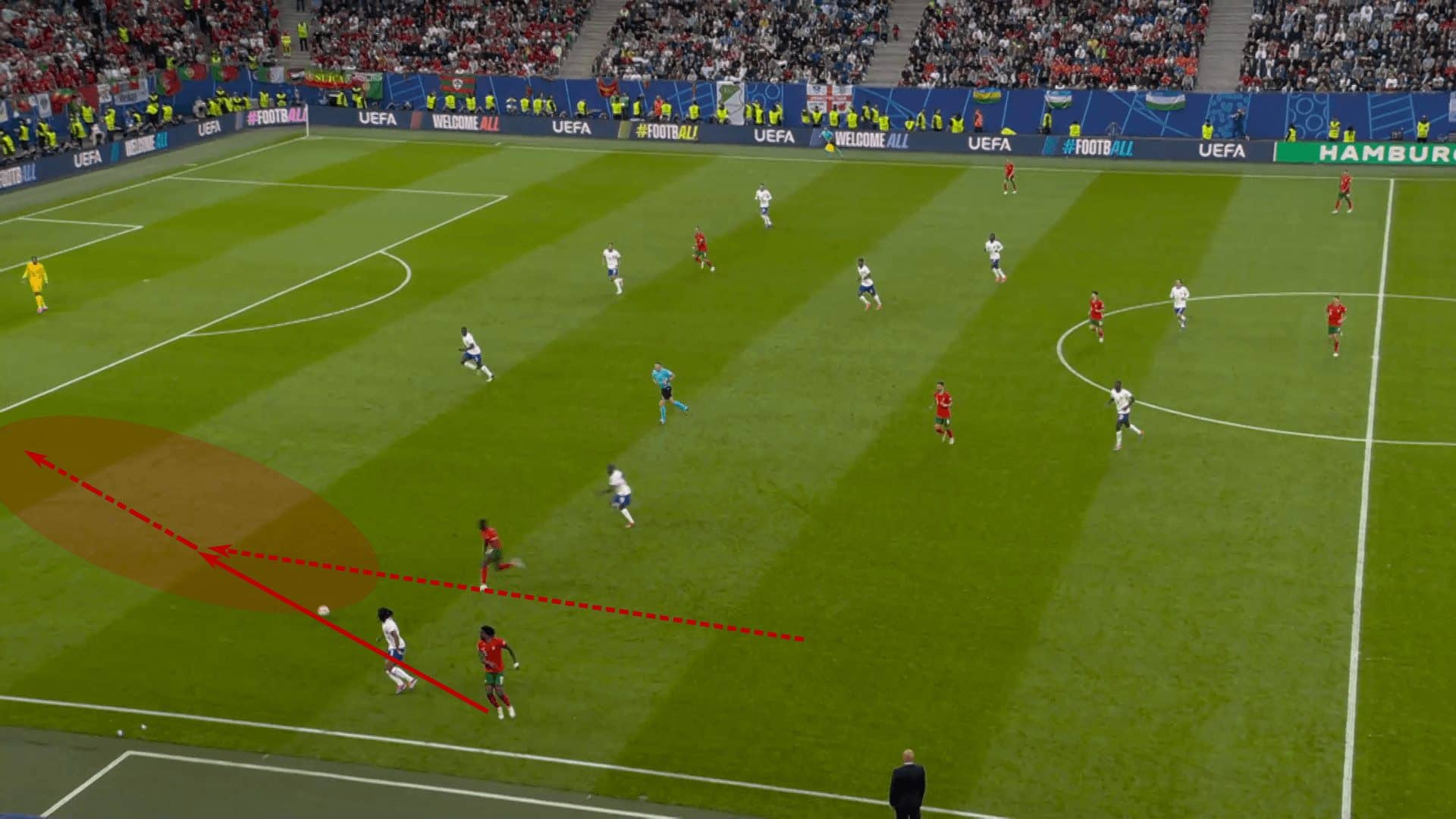
France often used one of the forwards or coverage from Camavinga to support Koundé and Dayot Upamecano. With those players recovering from higher and more narrow positions, if Spain can quickly get the ball into the wings, there’s an opportunity to create 2v1s for Williams and Lamine Yamal against the opponent or 1v1 scenarios with no coverage behind.
Pragmatism and low scorelines
While France hasn’t scored in open play, they haven’t conceded from open play either. The one goal allowed was a penalty kick by Robert Lewandowski. Defensively, they’re very solid and have world-class talent across the back line and in midfield. Given the limited risk they take in possession, the focus has clearly been on keeping the opponent off the scoreboard.
This interpretation of positional play contains a strong element of pragmatism, which stifles attacking play, both for and against France. With the talent at their disposal, opponents will struggle to score as much as France does.
Picking up the shot map for each team, Spain clearly holds an advantage in the volume and quality of the opportunities produced. To their credit, they essentially capitalized, making them one of the most effective attacking teams in the tournament.
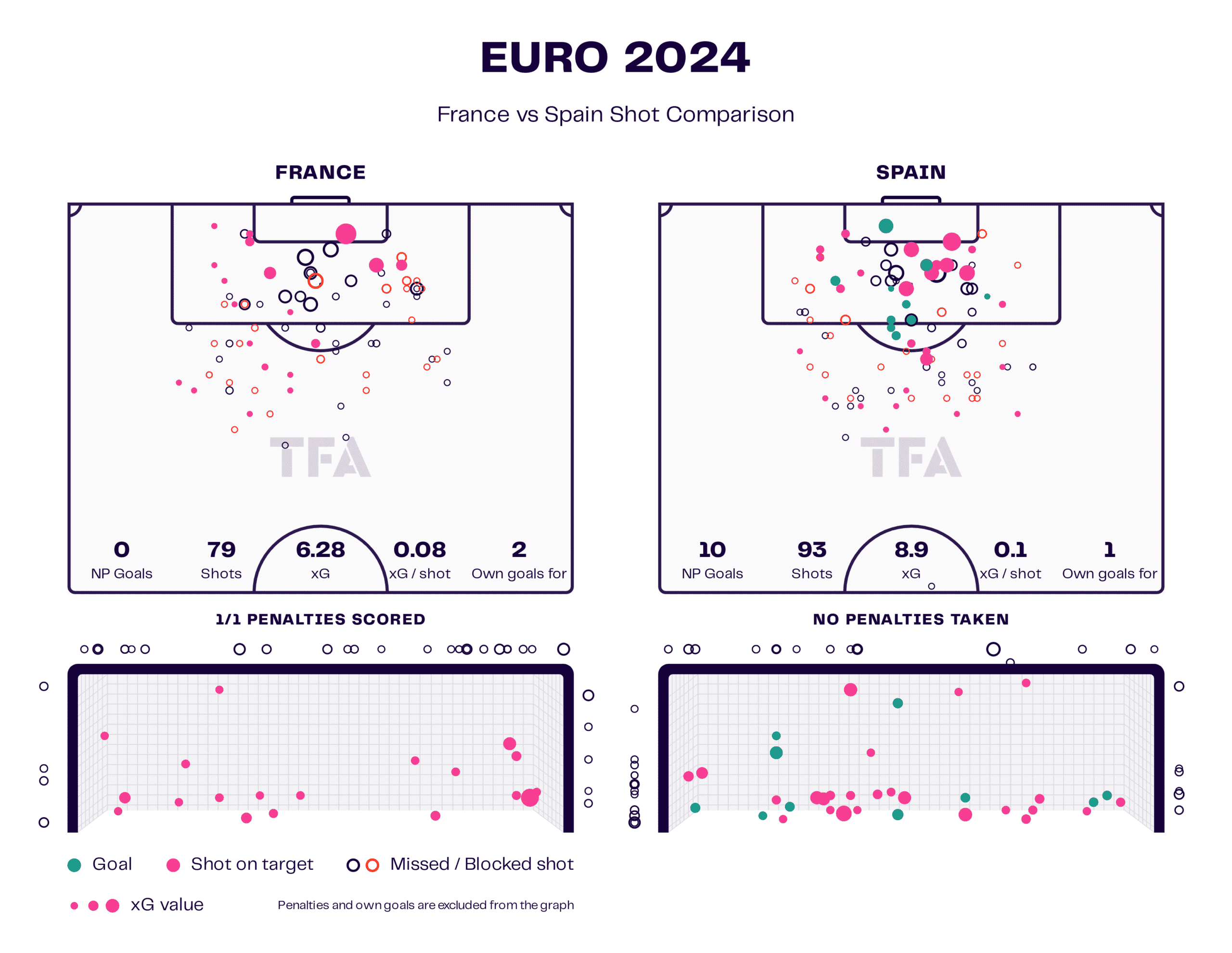
France, on the other hand, has an abysmal record. The low frequency of shots and the inability to apply the finish to the few good opportunities they’ve had have been stumbling blocks. The defensive performances have been necessary because of the poor quality of France’s attacking.
But the French have taken their defensive approach to a stifling extreme. Spain can expect their opponent to have at least nine players behind the ball at any given time, and often, only Mbappé is in front of the ball.
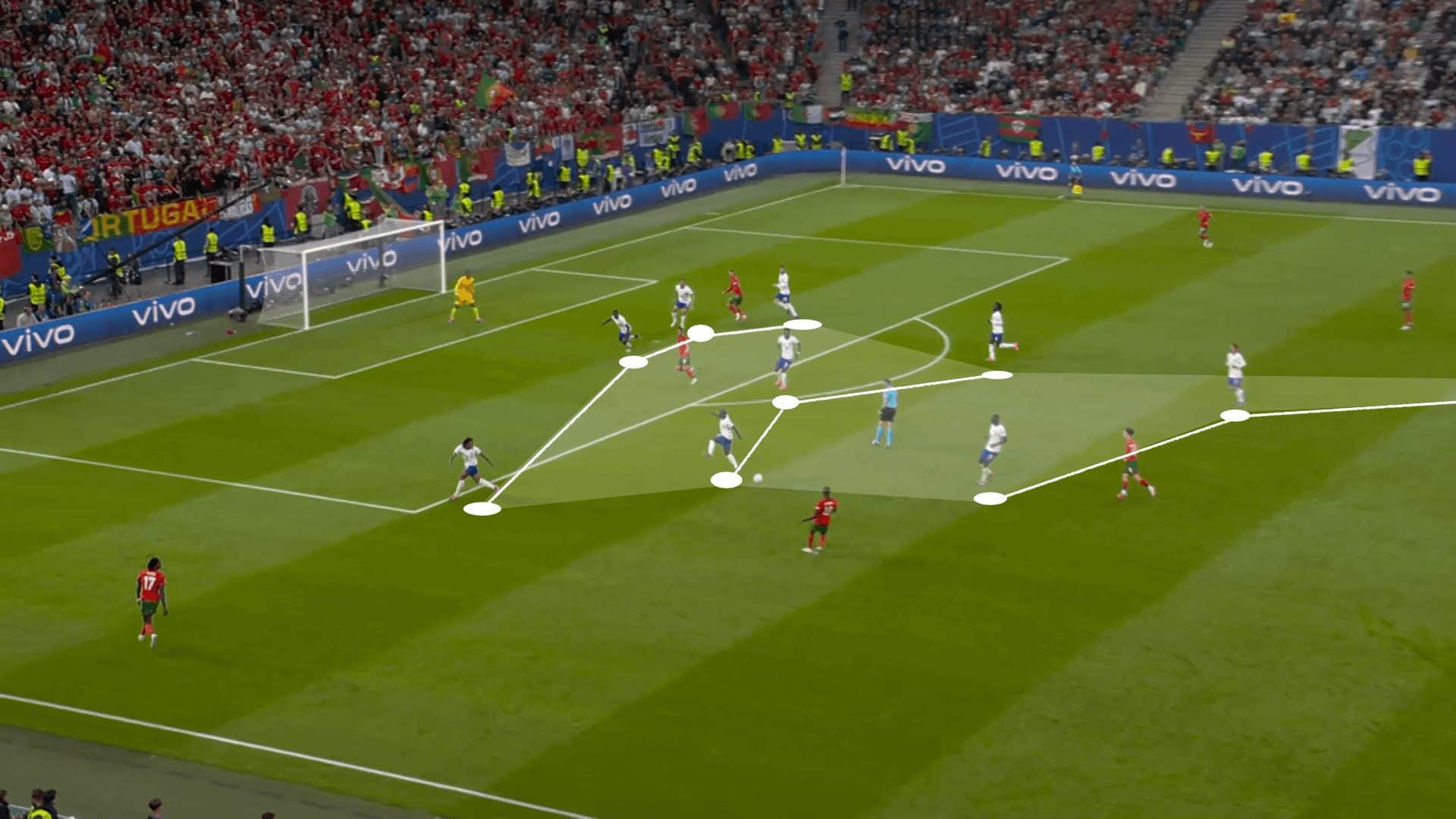
When Spain is in possession, attacking tempo will be critical. If they can catch France out of position, the wingers have to accelerate the attack while the second and third attackers aggressively push into goal-scoring positions. If they allow France to get numbers behind the ball, as they did in this instance against Germany, expect a low-scoring, low-tempo encounter with few quality opportunities.
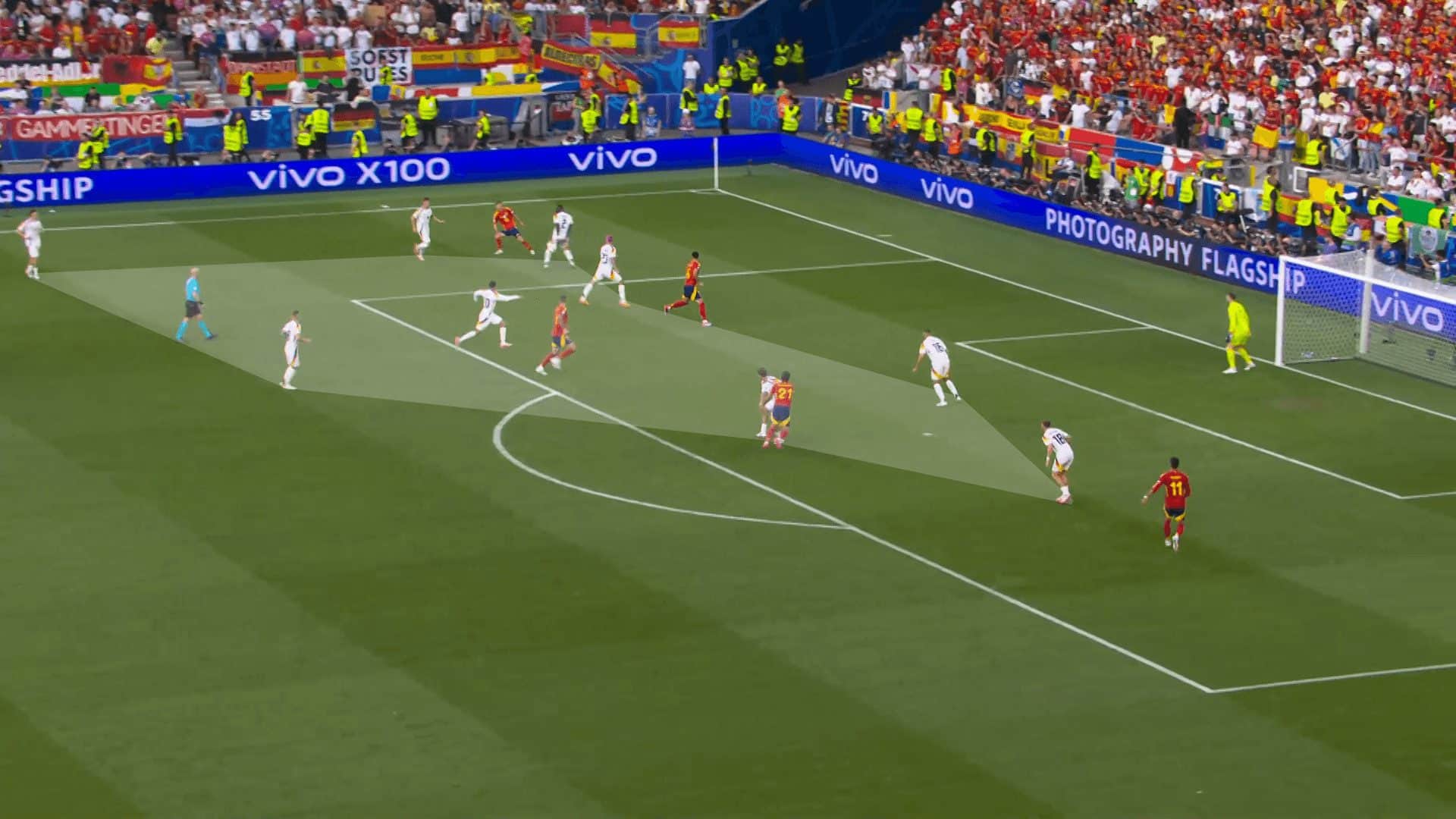
France’s defensive tactics have worked exceptionally well. Despite the criticism they’ve received for the use of the talent in their attacking tactics, which is undoubtedly deserved, their defending has smothered opponents, leading to this spot in the semi-final. It is the blueprint behind their places as finalists at the previous two World Cups.
Just looking at the shots faced by the goalkeeper image, one senses that France’s tactics have greatly limited the opposition’s shot quality. Any analysis of their tournament starts and ends with their defending tactics and pragmatic interpretation of positional play. As the saying goes, “You can’t lose if you don’t concede.” That sums up Didier Deschamps and his French side. Like the German and Italian teams of old, they may not excite the viewer, but they are wildly effective.
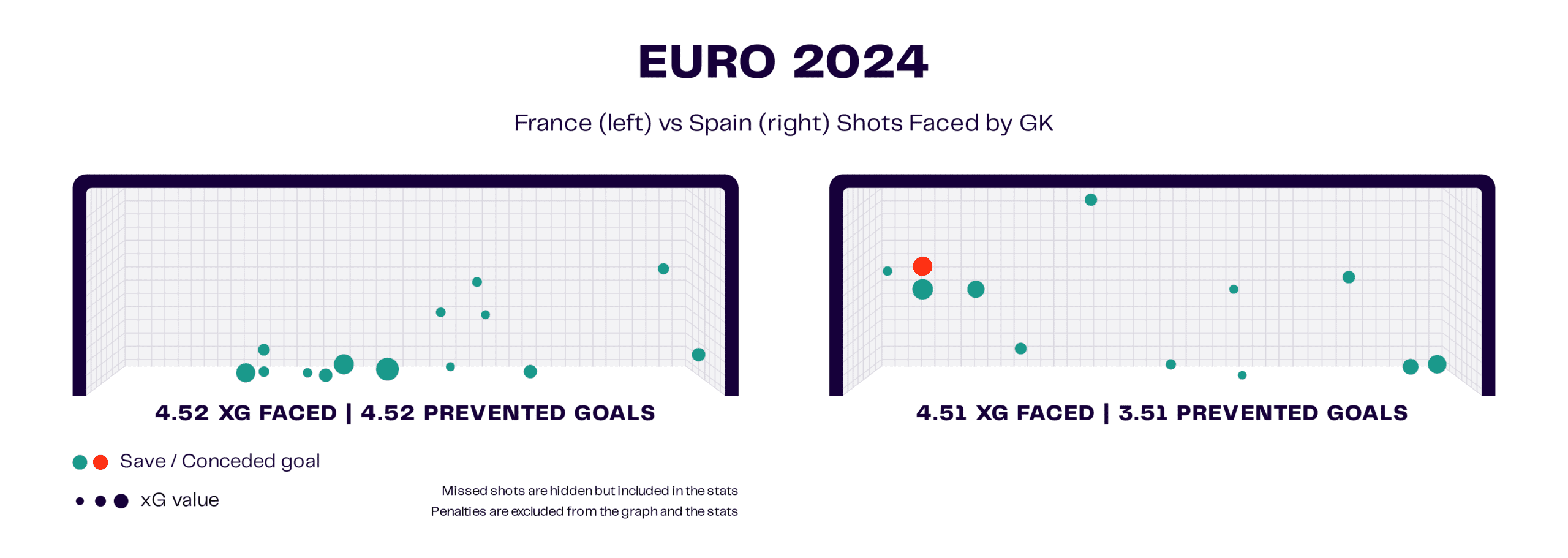
And this is the challenge for Spain. They have to find a way to unlock this stingy French defence. Pragmatism is core to their identity under Deschamps. After defeating the Euro 2016 tournament where the side played some brilliant football but ultimately lost in the final, this French side has scaled back from the energy and commitment to score goals and have shifted their approach to not allowing them.
Conclusion
The semi-final matchup offers a clear contrast.
We have the aggression and control of the Spanish with a strong dose of attacking flare against a French side that’s reluctant to accept risk and is strictly concerned with stifling the opponent.
In the bigger picture, this matchup will likely have implications for future tournaments, both at the 2026 World Cup and the 2028 Euros.
If France’s pragmatism frustrates and overcomes the Spanish, look for this trend to continue, even among the top teams. Should the Spanish overcome their neighbours to the northeast, their performance could shift trends towards a more progressive brand of football.
This is a fascinating matchup, both for the game itself and the implications for the way future tournaments are played. This is the battle between pragmatism and a more vibrant interpretation of positional play.





Comments